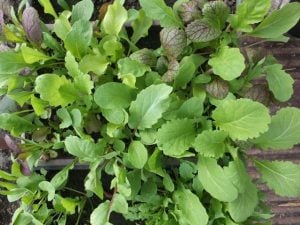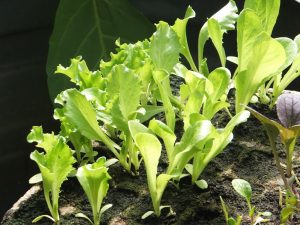I recently wrote that for a glasshouse watercress was the most nutritious crop you could grow, and that still stands. However the huge productive capacity under cover can be more efficiently harnessed to produce even more healthy nutrition. And a very succulent, delicious and tasty increase this is; from growing baby salad leaves.
You see in the past we mostly grew whole, semi-mature plants of such as lettuce, rocket, spring onion and so on for our salads. This is fine but without some effort and warmth it’s difficult to get much continuity of harvest. Most comes all at once as each crop ages and although batch sowing can spread the season over more weeks those are necessarily a long time wait from the day sown.

A recent change is we have taken to eating leaf salads where mixes of small, young / baby leaves are used instead of the heart of some whole plant. These are fresh, flavoursome, easier for many reasons, very quick and hugely productive.
The seed is sown and almost as soon as your first leaves are up they can start to be harvested. First individually nipped off, then cropped with scissors as the young seedlings bulk up. Little could be easier. You fill trays with seed compost then sow one of a huge range of proprietary salad leaf mixes, make up your own mix or even just sow some of your spare seeds.
For you can sow and eat just about any plant where we already eat leafy or root parts of the plant itself. However you must generally avoid those where we eat the seeds or fruits. (Tomatoes and potatoes have poisonous foliage as do most beans and aubergines.) Fortunately you can sow and eat the young leaves of most other ordinary garden vegetables. In fact seed companies are now offering special varieties of many just for this purpose. Kales and loose-leaf lettuce are particularly popular, as are spinaches, mustards, beets, and kitchen herbs such as chervil, dill and coriander.

Of course you can simply sow trays of established favourites such as rocket and spring onions, either separately or mixed together. Sow thick as the plants never get large as these will only grow for a few weeks before being cropped and discarded. This is so rapid, no waiting months to pick the entire plant.
Admittedly in order to keep up production you need to sow new trays each week but other than that watering is about the only care required. This must be tap water as you want to keep the foliage clean and hygienic. Few pests and diseases ever appear as the plants are gone so quickly, though usual culprits such as slugs and aphids may make the odd raid.
Finally, when each tray reaches the end its compost with roots and crop remains are brilliant for lining the bottom of big tubs for other plants.










